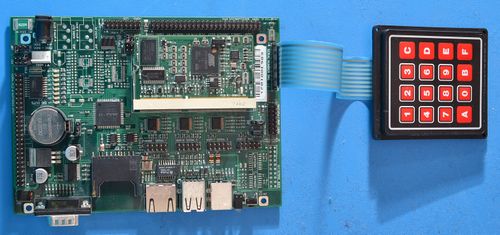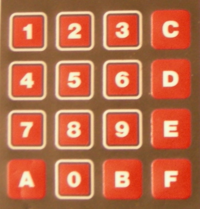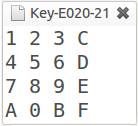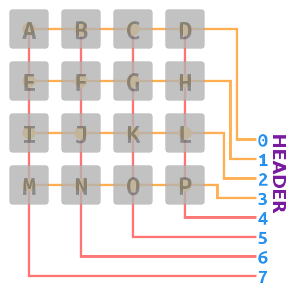Difference between revisions of "Example getkey"
m (Noted issues which need to be fixed.) |
|||
| (142 intermediate revisions by 5 users not shown) | |||
| Line 1: | Line 1: | ||
| − | {{todo| | + | {{todo|SEOKWREV (11.14.13-11:41->JG+);(11.14.13-15:30->MD-);(11.21.13-14:06->JG+);(11.21.13-16:15->MD-);(12.03.13-14:21->JG+);(01.04.14-17:01->JG+);(01.03.14-17:15->MD+);(01.03.14-17:35->KY+);(04.03.14-16:20->BS+)|Jgreene|project=oe 4,oe 5,jg,md,SEOKWREV,ky,bs}} |
| − | |||
| − | + | {{#seo: | |
| − | < | + | |title=Example getkey |
| + | |titlemode=append | ||
| + | |keywords=Example getkey,EMAC SOM-150ES,Using getkey,E020-21 Membrane hex style keypad | ||
| + | |description=This is a guide to the <code>getkey</code> C example project included in the EMAC OE SDK. | ||
| + | }} | ||
| + | This is a guide to the <code>getkey</code> C example project included in the EMAC OE SDK. | ||
| + | The <code>getkey</code> example C project demonstrates how to use a keypad with a SoM150ES carrier board. It provides examples of how to specify, inspect and test associations between character-data and keypad-keys. It demonstrates how to turn key-presses into character-data using the same techniques as the big keyboard on your PC. It's also a good introduction to the mysteries of matrix encoding (see [http://wikidev.emacinc.com/wiki/Example_getkey#A_Note_on_Matrix_Encoding A Note on Matrix Encoding, below]). | ||
| − | + | The <code>getkey</code> C example project creates one executable: <code>getkey</code>. | |
| − | + | == Opening, Building and Uploading the Project Files == | |
| − | + | For information on opening the project from within Eclipse, please see [[Importing the EMAC OE SDK Projects with Eclipse]]. Then, follow [[Using the EMAC OE SDK Projects with Eclipse]] for information on how to build, upload and execute the example. | |
| − | |||
| − | + | Alternatively, the <code>Makefile</code> can be used with the <code>make</code> command from the commandline to build and upload the example. For information on this method, please see [[Using EMAC OE SDK Example Projects]]. | |
| − | < | ||
| − | == | + | ====EMAC SDK 5.X==== |
| − | |||
| − | + | For information on opening the project from within QtCreator, please see [[Getting_Started_With_Qt_Creator#Adding_Source_Files | QtCreator: Adding Source Files]]. Then, follow [[Getting Started With Qt Creator]] for information on how to build, upload and execute the example. | |
| − | + | Alternatively, the <code>CMakefile.txt</code> can be used with the <code>cmake</code> command from the commandline to build and upload the example. For information on this method, please see [[Getting_Started_with_the_EMAC_OE_SDK#Target_Machine_Compiling | Getting Started with the EMAC OE SDK]]. | |
| − | |||
| − | |||
| − | |||
| − | + | Code can be found at http://git.emacinc.com/OE/example-projects | |
| − | + | ==Usage and Behavior== | |
| − | |||
| − | |||
| − | |||
| − | |||
| − | |||
| − | + | ===Hardware Requirements=== | |
| − | ''' | + | To use the '''getkey''' program requires the following hardware. |
| − | |||
| − | . | ||
| − | + | * A [http://www.emacinc.com/som/som150es.htm SOM-150ES carrier board] (Available from EMAC).<br /> | |
| + | * A compatible SoM for that carrier board ([http://www.emacinc.com/products/system_on_module/SoM-9260M SOM-9260M], [http://www.emacinc.com/som/som9G20.htm SOM-9G20M] and [http://www.emacinc.com/som/som9x25.htm SOM-9X25] are all compatible and available from EMAC).<br /> | ||
| + | * A compatible keypad ([http://www.emacinc.com/sbc_microcontroller_addons.htm Available from EMAC], refer to item# E20-21 or E020-25. [https://www.google.com/url?sa=t&rct=j&q=&esrc=s&source=web&cd=1&ved=0CCsQFjAA&url=http%3A%2F%2Fwww.in2tec.com%2Flib%2Fdownloadfile.php%3Ffilename%3D4000_series_keypads_datasheet.pdf%26loc%3Ddocuments%2F%26ct%3Dpdf&ei=Wf-MUrGxO-nEyQGggoGgCg&usg=AFQjCNEQxIaiH6-gx6uTq4O66o1YVDunZw&bvm=bv.56643336,d.aWc Datasheet]). | ||
| − | + | [[File:Som150 with keypad.JPG | 500px ]]<br /> | |
| + | SOM-150ES carrier board with keypad | ||
| − | + | ===Plugging the Keypad into the SOM-150ES Carrier Board=== | |
| − | + | Plug the keypad into the HDR5 KEYPAD header of the SOM-150ES Carrier Board.<br /> | |
| + | [[File:Example getkey howtopluginthekeypad 0.png|500px]] | ||
| − | ''' | + | Ensure that '''pin 0''' of the keypad's ribbon cable is lined up with '''pin 2''' on the header.<br /> |
| + | [[File:Example getkey howtopluginthekeypad 1.png|500px]] | ||
| − | + | ===The Keypad Matrix File=== | |
| − | The program will wait until a key is pressed on the keypad. When a key is pressed it will display the | + | The keypad matrix file specifies associations between keypad-keys and characters. For each key in the keypad's grid of keys we specify a character in a grid of characters. |
| + | |||
| + | [[File:Example_getkey_minimalkeypad.png|200px]] [[File: Example_getkey_matrixfile.png|150px]] | ||
| + | |||
| + | In this example we see an E020-21 keypad on the left and an example keypad matrix file (<code>Key-E020-21</code>, included in the project) opened in a text editor on the right. The character matrix may be freely edited to suit. | ||
| + | |||
| + | ====A Note on Matrix Encoding==== | ||
| + | |||
| + | Matrix Encoding is a technique for translating individual xy locations on a 2D matrix into unique integer values. Here we see locations in a 4x4 matrix being translated into an 8-bit value. Pins 0, 1, 2, 3 handle the key y coordinate; pins 4, 5, 6, 7 handle the x coordinate. Key '''A''' is at (7,0); '''B''':(6,0); '''K''':(5,2); Etc. | ||
| + | |||
| + | [[File:Matrix encoding.png]] | ||
| + | |||
| + | Thus, when a key is pressed, we get a corresponding integer value on the header.<br /> | ||
| + | For example: Pressing the '''F''' key sets the values on pins '''1''' and '''6''' to 1. This gives us a binary value of 01000010. Integer value: 66 . So when the value at the header equals 66, we know that the '''F''' key was pressed.<br /> | ||
| + | '''Note:''' This is an abstract, general example of a keypad using matrix encoding. Your keypad will probably have different characters on it's keys and output slightly different values. | ||
| + | |||
| + | ===Using getkey=== | ||
| + | |||
| + | The '''getkey''' program is controlled from the console via command line parameters. You can specify the keypad device node, specify the keypad matrix file (see notes on the [http://wikidev.emacinc.com/wiki/Example_getkey#The_Keypad_Matrix_File keypad matrix file], above), display the current matrix in the console and test individual character-key associations. | ||
| + | |||
| + | <code>./getkey [-d device -b -g -s file]</code> | ||
| + | |||
| + | ;-d:Specify the keypad device node. The default is <code>/dev/keypad</code> | ||
| + | ;-b:Test an individual key-character association (via "read blocking"). The program will sleep until a key on the keypad is pressed, then output that key's character to the console. | ||
| + | ;-g:Outputs the current keypad matrix (see notes on the [http://wikidev.emacinc.com/wiki/Example_getkey#The_Keypad_Matrix_File keypad matrix file], above) to the console. | ||
| + | ;-s:Specify the keypad matrix file. (see notes on the [http://wikidev.emacinc.com/wiki/Example_getkey#The_Keypad_Matrix_File keypad matrix file], above). If a keypad matrix file is not specified then the character associated with the last keypad key pressed is returned. | ||
| + | |||
| + | '''Note on parameter order:''' Parameters are evaluated in order. If blocking ('''b''') or device specifications ('''d''') are used, they must be declared before the matrix arguments on the command line. | ||
| + | |||
| + | ===Usage Example. Mapping a Keypad Device Node to a Keypad Matrix File=== | ||
| + | |||
| + | <code>./getkey -d /dev/keypad0 -s /path/to/this/file/Key-E020-21</code> | ||
| + | |||
| + | The program will map the keypad at the device node <code>/dev/keypad0</code> to the matrix file <code>Key-E020-21</code>. This associates each character in the grid of characters in the matrix file (see notes on the [http://wikidev.emacinc.com/wiki/Example_getkey#The_Keypad_Matrix_File keypad matrix file], above) with a key in the grid of keys on the keypad. | ||
| + | |||
| + | ===Usage Example: Displaying the Character Presently Associated With a Key on the Keypad=== | ||
| + | |||
| + | <code>./getkey -d /dev/keypad0 -b</code> | ||
| + | |||
| + | The program will wait until a key is pressed on the keypad. When a key is pressed it will display the character associated with that pressed key, as specified in the keypad matrix file (see notes on the [http://wikidev.emacinc.com/wiki/Example_getkey#The_Keypad_Matrix_File keypad matrix file], above). | ||
| + | |||
| + | For example: | ||
| + | <syntaxhighlight lang="console"> | ||
| + | root@som9g20:/tmp# ./getkey -d /dev/keypad0 -b | ||
| + | 5 | ||
| + | root@som9g20:/tmp# | ||
| + | </syntaxhighlight> | ||
| + | In this case, the '''5''' key on the keypad was pressed. | ||
| + | |||
| + | ===Usage Example. Displaying the Character Matrix Presently Associated with the Keypad=== | ||
| + | |||
| + | <code>./getkey -d /dev/keypad0 -g</code> | ||
| + | |||
| + | The program will display the character matrix (see notes on the [http://wikidev.emacinc.com/wiki/Example_getkey#The_Keypad_Matrix_File keypad matrix file], above) presently associated with the keypad at <code>/dev/keypad0''</code>. | ||
| + | |||
| + | <syntaxhighlight lang="console"> | ||
| + | root@som9g20:/tmp# ./getkey -d /dev/keypad0 -g | ||
| + | 1 2 3 C | ||
| + | 4 5 6 D | ||
| + | 7 8 9 E | ||
| + | A 0 B F | ||
| + | root@som9g20:/tmp# | ||
| + | </syntaxhighlight> | ||
| + | The character matrix displayed here is that of the <code>Key-E020-21</code> file. | ||
| + | |||
| + | ==Summary== | ||
| + | |||
| + | The <code>getkey</code> example C project demonstrates how to use a keypad with a SoM150ES carrier board. | ||
Latest revision as of 14:20, 30 November 2022
This is a guide to the getkey C example project included in the EMAC OE SDK.
The getkey example C project demonstrates how to use a keypad with a SoM150ES carrier board. It provides examples of how to specify, inspect and test associations between character-data and keypad-keys. It demonstrates how to turn key-presses into character-data using the same techniques as the big keyboard on your PC. It's also a good introduction to the mysteries of matrix encoding (see A Note on Matrix Encoding, below).
The getkey C example project creates one executable: getkey.
Contents
- 1 Opening, Building and Uploading the Project Files
- 2 Usage and Behavior
- 2.1 Hardware Requirements
- 2.2 Plugging the Keypad into the SOM-150ES Carrier Board
- 2.3 The Keypad Matrix File
- 2.4 Using getkey
- 2.5 Usage Example. Mapping a Keypad Device Node to a Keypad Matrix File
- 2.6 Usage Example: Displaying the Character Presently Associated With a Key on the Keypad
- 2.7 Usage Example. Displaying the Character Matrix Presently Associated with the Keypad
- 3 Summary
Opening, Building and Uploading the Project Files
For information on opening the project from within Eclipse, please see Importing the EMAC OE SDK Projects with Eclipse. Then, follow Using the EMAC OE SDK Projects with Eclipse for information on how to build, upload and execute the example.
Alternatively, the Makefile can be used with the make command from the commandline to build and upload the example. For information on this method, please see Using EMAC OE SDK Example Projects.
EMAC SDK 5.X
For information on opening the project from within QtCreator, please see QtCreator: Adding Source Files. Then, follow Getting Started With Qt Creator for information on how to build, upload and execute the example.
Alternatively, the CMakefile.txt can be used with the cmake command from the commandline to build and upload the example. For information on this method, please see Getting Started with the EMAC OE SDK.
Code can be found at http://git.emacinc.com/OE/example-projects
Usage and Behavior
Hardware Requirements
To use the getkey program requires the following hardware.
- A SOM-150ES carrier board (Available from EMAC).
- A compatible SoM for that carrier board (SOM-9260M, SOM-9G20M and SOM-9X25 are all compatible and available from EMAC).
- A compatible keypad (Available from EMAC, refer to item# E20-21 or E020-25. Datasheet).
SOM-150ES carrier board with keypad
Plugging the Keypad into the SOM-150ES Carrier Board
Plug the keypad into the HDR5 KEYPAD header of the SOM-150ES Carrier Board.
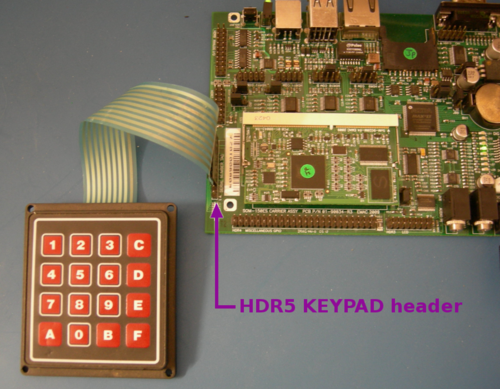
Ensure that pin 0 of the keypad's ribbon cable is lined up with pin 2 on the header.
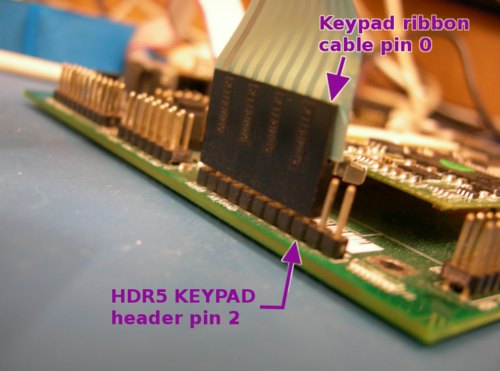
The Keypad Matrix File
The keypad matrix file specifies associations between keypad-keys and characters. For each key in the keypad's grid of keys we specify a character in a grid of characters.
In this example we see an E020-21 keypad on the left and an example keypad matrix file (Key-E020-21, included in the project) opened in a text editor on the right. The character matrix may be freely edited to suit.
A Note on Matrix Encoding
Matrix Encoding is a technique for translating individual xy locations on a 2D matrix into unique integer values. Here we see locations in a 4x4 matrix being translated into an 8-bit value. Pins 0, 1, 2, 3 handle the key y coordinate; pins 4, 5, 6, 7 handle the x coordinate. Key A is at (7,0); B:(6,0); K:(5,2); Etc.
Thus, when a key is pressed, we get a corresponding integer value on the header.
For example: Pressing the F key sets the values on pins 1 and 6 to 1. This gives us a binary value of 01000010. Integer value: 66 . So when the value at the header equals 66, we know that the F key was pressed.
Note: This is an abstract, general example of a keypad using matrix encoding. Your keypad will probably have different characters on it's keys and output slightly different values.
Using getkey
The getkey program is controlled from the console via command line parameters. You can specify the keypad device node, specify the keypad matrix file (see notes on the keypad matrix file, above), display the current matrix in the console and test individual character-key associations.
./getkey [-d device -b -g -s file]
- -d
- Specify the keypad device node. The default is
/dev/keypad - -b
- Test an individual key-character association (via "read blocking"). The program will sleep until a key on the keypad is pressed, then output that key's character to the console.
- -g
- Outputs the current keypad matrix (see notes on the keypad matrix file, above) to the console.
- -s
- Specify the keypad matrix file. (see notes on the keypad matrix file, above). If a keypad matrix file is not specified then the character associated with the last keypad key pressed is returned.
Note on parameter order: Parameters are evaluated in order. If blocking (b) or device specifications (d) are used, they must be declared before the matrix arguments on the command line.
Usage Example. Mapping a Keypad Device Node to a Keypad Matrix File
./getkey -d /dev/keypad0 -s /path/to/this/file/Key-E020-21
The program will map the keypad at the device node /dev/keypad0 to the matrix file Key-E020-21. This associates each character in the grid of characters in the matrix file (see notes on the keypad matrix file, above) with a key in the grid of keys on the keypad.
Usage Example: Displaying the Character Presently Associated With a Key on the Keypad
./getkey -d /dev/keypad0 -b
The program will wait until a key is pressed on the keypad. When a key is pressed it will display the character associated with that pressed key, as specified in the keypad matrix file (see notes on the keypad matrix file, above).
For example:
root@som9g20:/tmp# ./getkey -d /dev/keypad0 -b
5
root@som9g20:/tmp#
In this case, the 5 key on the keypad was pressed.
Usage Example. Displaying the Character Matrix Presently Associated with the Keypad
./getkey -d /dev/keypad0 -g
The program will display the character matrix (see notes on the keypad matrix file, above) presently associated with the keypad at /dev/keypad0.
root@som9g20:/tmp# ./getkey -d /dev/keypad0 -g
1 2 3 C
4 5 6 D
7 8 9 E
A 0 B F
root@som9g20:/tmp#
The character matrix displayed here is that of the Key-E020-21 file.
Summary
The getkey example C project demonstrates how to use a keypad with a SoM150ES carrier board.
